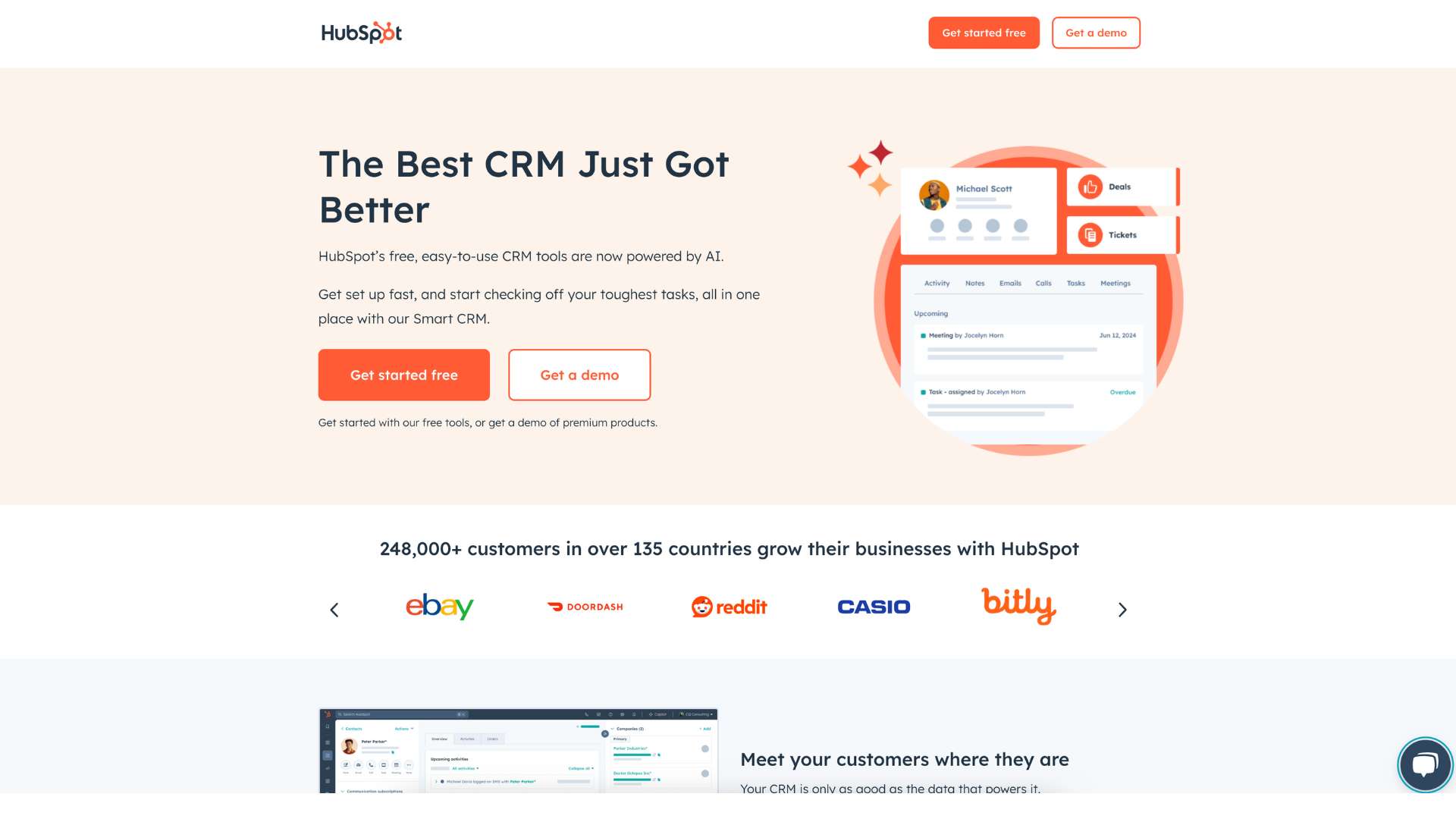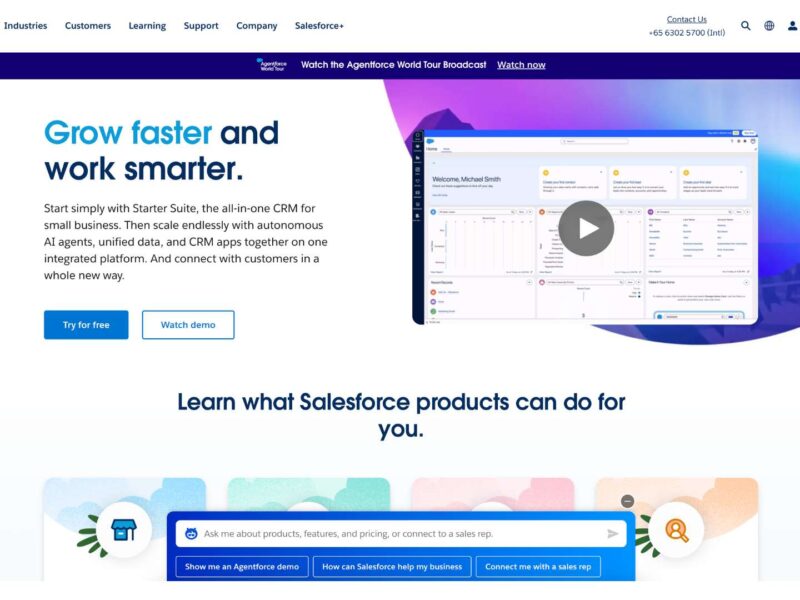HubSpot CRM Review: Features, Pricing, Pros & Cons
HubSpot CRM is a cloud-based customer relationship management platform designed to unify marketing, sales, and service teams. It offers contact management, pipeline tracking, email automation, live chat, and AI tools—designed to eliminate silos and enhance customer interactions.
Businesses often struggle with fragmented processes across departments. HubSpot CRM solves this by providing an all-in-one solution where contacts, deals, support tickets, and automation workflows are centralized in one intuitive interface.
Ideal users include startups, small-to-medium businesses, marketing agencies, sales teams, and enterprises seeking scalable CRM capability with minimal initial investment.
Company Background
HubSpot, Inc. is an American software company founded in 2006 by Brian Halligan and Dharmesh Shah in Cambridge, Massachusetts. Since its IPO in 2014, it has grown to over 8,200 employees and reached $2.17 billion in subscription revenue in 2023.
Known for pioneering inbound marketing, HubSpot built its foundation on free tools that attracted users into paid products. Landmark acquisitions include Kemvi (AI/ML for sales) in 2017, Clearbit (B2B intelligence) in 2023, and Frame AI (conversation intelligence) in December 2024.
HubSpot’s current CEO is Yamini Rangan, with founders still engaged as CTO (Shah) and Executive Chairman (Halligan). The company’s evolution includes launches such as Marketing Hub, Service Hub, Operations Hub, CMS Hub, and Commerce Hub—making the CRM the core of a broader “Customer Platform”.
Key Features
HubSpot’s offerings are grouped into logical suites with functionality that grows with your business.
Contact & Deal Management
- Central CRM database holds unlimited contacts and companies on the free plan.
- Visual deal pipelines with drag-and-drop stages and task automation.
- Customizable contact records track activities—calls, emails, website interactions, lead scoring.
Marketing & Lead Generation
- Built‑in email marketing with drag-and-drop builder, A/B testing, and AI‑powered subject lines .
- Landing pages and forms (embedded, pop-up, slide-in) tied to CRM for lead capture.
- Automated workflows and smart lists for segmentation and nurturing.
- Ads management syncs campaign performance into CRM.
Sales Tools & Automation
- Email templates, tracking, sequences, and meeting schedules with integrations.
- AI‑powered prospecting tools that save reps 2+ hours per day.
- Sales dashboards and forecasting built into Sales Hub.
Customer Service & Support
- Ticket pipelines, live chat widgets, and chatbots (“chatflows”) for real-time support.
- Universal inbox consolidates email, chat, Messenger, and WhatsApp
- Knowledge base builder, feedback surveys, and sentiment analysis.
Reporting & Analytics
- Real-time dashboards and custom report builders across hubs.
- Funnel, revenue, and activity forecasting tied to pipeline data.
Integrations & App Marketplace
- 1,500+ app integrations—Gmail, Outlook, Zoom, WordPress, Salesforce, Shopify, and more.
- API and Zapier support for advanced automation.
AI & Automation
- AI‑generated email body and subject lines, smart content tools.
- Predictive lead scoring, data enrichment, and buyer intent are powered by HubSpot Credits.
- Breeze Intelligence and Customer Agent features are included via credits.
UI/UX and Onboarding
HubSpot CRM offers a modern, intuitive interface built for simplicity:
- Dashboards and pipelines are user-friendly and visually clear.
- Onboarding includes guided wizards, in-app tooltips, and HubSpot Academy tutorials.
- Desktop-like experience on web; mobile apps support calls, tasks, and contact access.
- Accessibility is thoughtfully implemented (keyboard navigation, contrast).
Most users note the platform’s ease of use from day one.
Platforms Supported
| Platform | Availability | Notes |
|---|---|---|
| Web | ✅ | Cloud-based; no installation |
| Desktop | ❌ | No native app; web works well |
| Mobile (iOS/Android) | ✅ | Manage contacts, tasks, email, calls |
| Offline | ❌ | Internet access required |
Pricing
HubSpot’s modular pricing lets you mix and match across hubs. Below are the core plans:
| Plan / Hub | Price* | Key Features |
|---|---|---|
| Free CRM | $0 | Contact mgmt, pipelines, forms, ticketing, live chat, email tracking, 1 M contacts |
| Starter (each hub) | From $20/mo per seat (annual) | Ad branding removal, snippets, 1,000 custom properties, basic automation |
| Professional (each hub) | Sales/Service $100/seats; Marketing $890; ☑ | Workflows, custom reports, multiple pipelines |
| Enterprise (each hub) | Sales/Service $150/seats; Marketing $3,600; ☑ | Advanced permissions, revenue analytics, team management |
*Marketing hub pricing based on contact volume tiers.Usage-based features like AI credits are included (500 Starter, 3,000 Professional, 5,000 Enterprise)
HubSpot also offers bundled “Customer Platform” plans combining all hubs starting at $50/mo (Starter), $1,781/mo (Professional), and $5,000/mo (Enterprise).
Additional costs may include onboarding fees ($1,500–$3,500 for Pro/Enterprise).
Pros and Cons
Pros
- Generous free plan: Unlimited users, up to 1 million contacts
- User-friendly interface: Easy setup, clean design
- All-in-one platform: Sales, marketing, support with shared CRM
- AI and automation: Saves hours via workflows and generative content
- Learning support: Free HubSpot Academy, community, documentation
Cons
- Costly at scale: Pro/Enterprise tiers are expensive with onboarding fees
- Limited customization without Enterprise: Fewer custom rules on Starter/Pro
- Free tiers lack offline access: Requires an internet connection
- Template designs are basic: Email/landing page templates lack sophistication.
Customer Support & Resources
HubSpot offers robust support options:
- Live chat & email through all plans (priority for paid tiers)
- Phone support for Pro and Enterprise
- HubSpot Academy with free certifications, webinars, tutorials
- Knowledge base and in-app help is comprehensive
- Community forums offer peer-driven assistance
Users consistently praise support quality and self-service resources.
Real-World Use Cases / Ideal Users
- Digital Marketing Agencies: Manage campaigns, automate nurturing, and report results—all under one dashboard.
- B2B Sales Teams: Visual pipelines, sequences, email tracking, and AI suggestion tools streamline outreach and deal management.
- E‑commerce Merchants: Capture leads via forms, send personalized email campaigns, and provide real-time support through chatflows.
- Customer Support Teams: Leverage ticket pipelines and live chat to resolve issues faster and track metrics.
- Growing Startups: Begin with free plan, then scale into Pro and Enterprise as needs increase—without migration hurdles.
One notable user, Trello (Atlassian), uses HubSpot to align sales teams globally . Strava and Docebo also rely on HubSpot for lead nurturing and pipeline tracking.
User Reviews and Ratings
- G2: 4.4/5 — praised for UI, integrated automation
- Capterra: 4.5/5 — popular with small teams for ease-of-use
- TechRepublic (Allyssa Haygood‑Taylor): Highlights AI tools and integration breadth
- TechRadar: Described as feature-rich with a free plan; warns of cost escalation
Sample user quotes:
“The free version alone is better than many paid CRMs.” – Sarah M., Marketing Director
Rating consensus: excellent UX and free version; premium tiers justified only if advanced features are needed.
Best Alternatives
| Competitor | Best For | Comparison Summary |
|---|---|---|
| Zoho CRM | Affordable SMB/PIM solutions | Cheaper than HubSpot Pro/Enterprise; fewer integrations/AI capabilities |
| Salesforce | Large enterprises needing deep customization | Far more configurable, but more complex and pricier |
| Pipedrive | Sales pipeline visualization | Simplified, effective for pure sales; lacks unified marketing/service stacks |
| Freshsales | Budget AI-driven SMB sales tool | Cheaper, strong AI; fewer marketing integrations |
| Insightly | Project+CRM workflows | Ideal for project-centric businesses; smaller marketplace |
Summary
HubSpot CRM offers an unmatched combination of accessibility and scale. Its free plan provides core tools large enough for startups, while its modular hub system allows businesses to upgrade affordably. Features such as AI-driven drafting and predictive scoring significantly boost productivity.
However, costs rise steeply at the Professional and Enterprise levels. Organizations should assess whether they’ll need to scale before committing, especially factoring in onboarding fees. Still, HubSpot’s intuitive design, unified data model, strong automation, and resource base offer high ROI for businesses looking to grow.
For those after a proven, scalable CRM with marketing, sales, and support tightly integrated, HubSpot remains a top-tier option. I recommend starting with the free plan to explore core features, then moving into Sales or Marketing Hubs as business needs increase.
Media
HubSpot CRM Tutorial for Beginners
How to Use HubSpot CRM (2025) | Full Guide For Beginners
How to Use HubSpot CRM – Tutorial for Beginners

